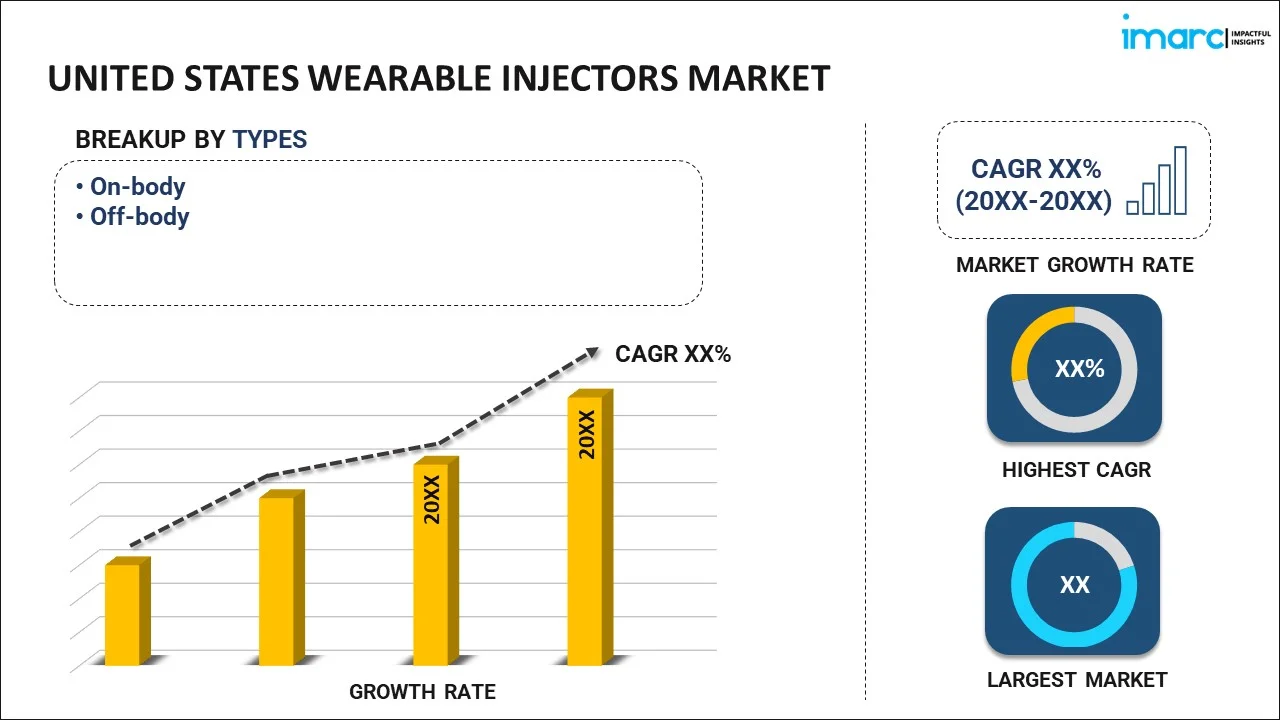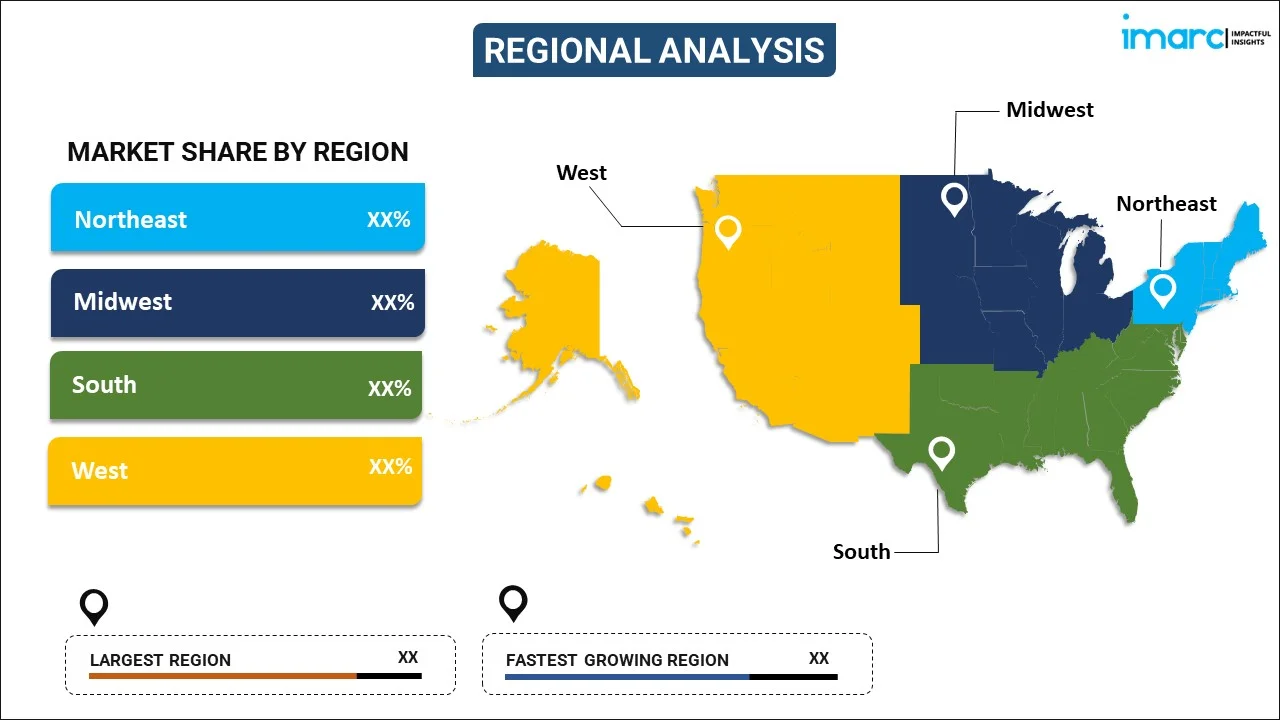
United States Wearable Injectors Market Report by Type (On-body, Off-body), Technology (Spring-based, Motor-driven, Rotary Pump, Expanding Battery, and Others), Application (Oncology, Infectious Diseases, Cardiovascular Diseases, Autoimmune Diseases, and Others), End Use (Hospitals and Clinics, Home Care, and Others), and Region 2024-2032
Market Overview:
United States wearable injectors market size is projected to exhibit a growth rate (CAGR) of 5.30% during 2024-2032. The increasing prevalence of several chronic conditions, such as diabetes, autoimmune diseases, and cardiovascular disorders, expanding aging population, and the expansion of home healthcare and telemedicine services represent some of the key factors driving the market.
|
Report Attribute
|
Key Statistics
|
|---|---|
|
Base Year
|
2023 |
|
Forecast Years
|
2024-2032 |
|
Historical Years
|
2018-2023
|
| Market Growth Rate (2024-2032) | 5.30% |
Wearable injectors are innovative medical devices that facilitate controlled delivery of medication or therapeutic substances subcutaneously over an extended period. These devices are usually worn on the body and provide a convenient and patient-friendly method of drug administration. They often feature programmable settings to customize the dosage and delivery schedule, ensuring precise and patient-specific treatment. They are equipped with safety mechanisms to prevent overuse or accidental injections. They can connect to smartphones or other devices, allowing healthcare providers to monitor patient adherence and adjust treatment remotely. They simplify medication administration, leading to higher patient compliance with treatment regimens. They are widely used by pharmaceutical companies in clinical trials to ensure precise drug delivery and collect valuable patient data.
United States Wearable Injectors Market Trends:
The increasing prevalence of several chronic conditions, such as diabetes, autoimmune diseases, and cardiovascular disorders, represents one of the primary factors driving the demand for wearable injectors in the United States. Additionally, the expanding geriatric population is driving the need for complex medication regimens for multiple chronic conditions. Along with this, the healthcare industry is increasingly shifting toward a patient-centric approach, focusing on enhancing the patient experience and improving outcomes, stimulating the market growth in the country. Apart from this, rapid advancements in technology are leading to the development of wearable injectors with enhanced features like programmable dosing, connectivity to smartphones, and integrated sensors for real-time monitoring. These technological enhancements make the devices more user-friendly and enable healthcare providers to remotely monitor and adjust treatment plans, leading to more personalized care. Furthermore, the expansion of home healthcare and telemedicine services is creating a conducive environment for the adoption of wearable injectors. Moreover, regulatory agencies, such as the US Food and Drug Administration (FDA), are actively supporting the development and approval of wearable injectors. US FDA approvals provide assurance to healthcare providers and patients regarding the safety and efficacy of these devices. Along with this, various pharmaceutical companies are increasingly partnering with device manufacturers to develop combination products that integrate medications with wearable injector technology. In line with this, the rising environmental consciousness among the masses and healthcare professionals is catalyzing the demand for wearable injectors. These devices can reduce the environmental impact associated with traditional healthcare practices, such as the disposal of syringes and vials. In addition, the growing trend towards personalized medicine is driving the demand for precise drug delivery methods. Besides this, several pharmaceutical and medical device companies in the country are making significant investments in research and development (R&D) activities to enhance wearable injector technology. This includes improving device usability, connectivity, and compatibility with a wide range of medications.
United States Wearable Injectors Market Segmentation:
IMARC Group provides an analysis of the key trends in each segment of the market, along with forecasts at the country level for 2024-2032. Our report has categorized the market based on type, technology, application, and end use.
Type Insights:

- On-body
- Off-body
The report has provided a detailed breakup and analysis of the market based on the type. This includes on-body and off-body.
Technology Insights:
- Spring-based
- Motor-driven
- Rotary Pump
- Expanding Battery
- Others
A detailed breakup and analysis of the market based on technology have also been provided in the report. This includes spring-based, motor-driven, rotary pump, expanding battery, and others.
Application Insights:
- Oncology
- Infectious Diseases
- Cardiovascular Diseases
- Autoimmune Diseases
- Others
The report has provided a detailed breakup and analysis of the market based on the application. This includes oncology, infectious diseases, cardiovascular diseases, autoimmune diseases, and others.
End Use Insights:
- Hospitals and Clinics
- Home Care
- Others
A detailed breakup and analysis of the market based on end use have also been provided in the report. This includes hospitals and clinics, home care, and others.
Regional Insights:

- Northeast
- Midwest
- South
- West
The report has also provided a comprehensive analysis of all the major regional markets, which include the Northeast, Midwest, South, and West.
Competitive Landscape:
The market research report has also provided a comprehensive analysis of the competitive landscape in the market. Competitive analysis such as market structure, key player positioning, top winning strategies, competitive dashboard, and company evaluation quadrant has been covered in the report. Also, detailed profiles of all major companies have been provided.
United States Wearable Injectors Market Report Coverage:
| Report Features | Details |
|---|---|
| Base Year of the Analysis | 2023 |
| Historical Period | 2018-2023 |
| Forecast Period | 2024-2032 |
| Units | US$ Million |
| Scope of the Report | Exploration of Historical Trends and Market Outlook, Industry Catalysts and Challenges, Segment-Wise Historical and Future Market Assessment:
|
| Types Covered | On-body, Off-body |
| Technologies Covered | Spring-based, Motor-driven, Rotary Pump, Expanding Battery, Others |
| Applications Covered | Oncology, Infectious Diseases, Cardiovascular Diseases, Autoimmune Diseases, Others |
| End Uses Covered | Hospitals and Clinics, Home Care, Others |
| Regions Covered | Northeast, Midwest, South, West |
| Customization Scope | 10% Free Customization |
| Report Price and Purchase Option | Single User License: US$ 3699 Five User License: US$ 4699 Corporate License: US$ 5699 |
| Post-Sale Analyst Support | 10-12 Weeks |
| Delivery Format | PDF and Excel through Email (We can also provide the editable version of the report in PPT/Word format on special request) |
Key Questions Answered in This Report:
- How has the United States wearable injectors market performed so far and how will it perform in the coming years?
- What has been the impact of COVID-19 on the United States wearable injectors market?
- What is the breakup of the United States wearable injectors market on the basis of type?
- What is the breakup of the United States wearable injectors market on the basis of technology?
- What is the breakup of the United States wearable injectors market on the basis of application?
- What is the breakup of the United States wearable injectors market on the basis of end use?
- What are the various stages in the value chain of the United States wearable injectors market?
- What are the key driving factors and challenges in the United States wearable injectors?
- What is the structure of the United States wearable injectors market and who are the key players?
- What is the degree of competition in the United States wearable injectors market?
Key Benefits for Stakeholders:
- IMARC’s industry report offers a comprehensive quantitative analysis of various market segments, historical and current market trends, market forecasts, and dynamics of the United States wearable injectors market from 2018-2032.
- The research report provides the latest information on the market drivers, challenges, and opportunities in the United States wearable injectors market.
- Porter's five forces analysis assist stakeholders in assessing the impact of new entrants, competitive rivalry, supplier power, buyer power, and the threat of substitution. It helps stakeholders to analyze the level of competition within the United States wearable injectors industry and its attractiveness.
- A competitive landscape allows stakeholders to understand their competitive environment and provides an insight into the current positions of key players in the market.
Need more help?
- Speak to our experienced analysts for insights on the current market scenarios.
- Include additional segments and countries to customize the report as per your requirement.
- Gain an unparalleled competitive advantage in your domain by understanding how to utilize the report and positively impacting your operations and revenue.
- For further assistance, please connect with our analysts.
 Inquire Before Buying
Inquire Before Buying
 Speak to an Analyst
Speak to an Analyst
 Request Brochure
Request Brochure
 Request Customization
Request Customization




.webp)




.webp)












